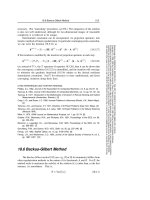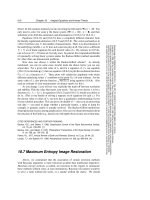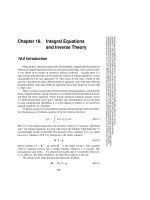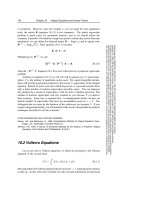Textual Conspiracies Walter Benjamin, Idolatry, and Political Theory pptx
Bạn đang xem bản rút gọn của tài liệu. Xem và tải ngay bản đầy đủ của tài liệu tại đây (1.16 MB, 318 trang )
Textual Conspiracies
Textual Conspiracies
Walter Benjamin, Idolatry, and
Political Theory
James R. Martel
the university of michigan press
Ann Arbor
Copyright © by the University of Michigan 2011
All rights reserved
This book may not be reproduced, in whole or in part,
including illustrations, in any form (beyond that copying
permitted by Sections 107 and 108 of the U.S. Copyright Law
and except by reviewers for the public press), without
written permission from the publisher.
Published in the United States of America by
The University of Michigan Press
Manufactured in the United States of America
c Printed on acid-free paper
2014 2013 2012 2011 4 3 2 1
A CIP catalog record for this book is available from the British Library.
Library of Congress Cataloging-in-Publication Data
Martel, James R.
Textual conspiracies : Walter Benjamin, idolatry, and political
theory / James R. Martel.
p. cm.
Includes bibliographical references and index.
isbn 978-0-472-11772-7 (cloth : alk. paper)
isbn 978-0-472-02819-1 (e-book)
1. Benjamin, Walter, 1892–1940—Political and social views.
2. Capitalism. 3. Liberalism. 4. Conspiracies. 5. Politics and
literature. I. Title.
pt2603.e455z73315 2011
838'.91209—dc22 2011007220
Acknowledgments
I want to express thanks to many people who helped me to write this
book. Two people in particular merit great thanks for this book’s publica-
tion. Joyce Seltzer has been an invaluable friend, advisor, and mentor in
facing the publishing world and conceptualizing my projects, this one
very much included. Melody Herr has been a phenomenal editor; her ad-
vice, enthusiasm, and advocacy have made getting this book to press a
truly enjoyable experience. Susan Cronin, Kevin Rennells, and Mike Ke-
hoe have also been very helpful at University of Michigan Press. I also
want to thank my university, San Francisco State University, and especially
my dean, Joel Kassiola, for giving me a sabbatical to help ‹nish this proj-
ect and for his support in general. Jodi Dean was instrumental in starting
this project; she got me thinking about conspiracy in the ‹rst place and
has been an astute and generous reader. Karen Feldman has also been a
great reader and was present at the ‹rst incarnations of my work on Kafka.
In October 2010, I was fortunate to be able to present the principal ar-
guments for this text at a conference entitled “Dangerous Crossings: Poli-
tics at the Limits of the Human,” held at Johns Hopkins University. Thank
you to the conference organizers: Drew Walker, Nathan Gies, Katherine
Goktepe, and Tim Hana‹n. Thanks also to Jennifer Culbert, Jane Bennett,
Willam Connolly, and Bonnie Honig for their excellent comments and
contributions to my project as well as their friendship. Other readers, col-
leagues, allies, and friends include, as always, Nasser Hussain and Mark
Andrejevic, and many other people whose support and wisdom are in-
valuable to me: Marianne Constable, Ruth Sonderegger, Jackie Stevens,
Martha Umphrey, Paul Passavant, Angelika von Wahl, Melissa Ptacek,
Tiffany Willoughby-Herard, Sara Kendall, Wendy Lochner, Jeanne
Scheper, Zhivka Valiavicharska, Jimmy Casas Klausen, Alex Dubilet, Ra-
mona Naddaff, Lisa Disch, Stephanie Sommerfeld, Adam Thurschwell,
Kennan Ferguson, David Bates, Shalini Satkunanandan, Stuart Murray,
Anatole Anton, Sandra Luft, Anatoli Ignatov, Miguel Vatter, Libby Anker,
Alex Hirsch, Vicky Kahn, Keally McBride, Dean Mathiowetz, Brian
Weiner, Ron Sundstrom, Kate Gordy, Wendy Brown, Kyong-Min Son,
William Sokoloff, Vanessa Lemm, Tom Dumm, Peter Fitzpatrick, Colin
Perrin, Austin Sarat, Linda Ross Meyer, and many others. I want to thank
my many students in my two (to date) Walter Benjamin graduate semi-
nars at SFSU including Loren Lewis, Evan Stern, Rion Roberts, Steven
Swarbrick, Sharise Edwards, Tyler Nelson, Dieyana Ruzgani, Loren Stew-
art, Katrina Lappin, Veronica Roberts, Kenny Loui, Joshua Hurni, Cecily
Gonzalez, Rebecca Stillman, Randall Cohn, Brooks Kirchgassner, and
quite a few others. Finally I want to thank my wonderful family: my hus-
band, Carlos, my children, Jacques and Rocio, and Nina, Kathryn, Elic and
Mark, Ralph, Huguette, Django, and Shalini.
I give thanks to my mother, Huguette Martel, for her painting that is
used on the book cover. Thanks also go to Alice Martin at Service IMEC
Images (which holds the Gisèle Freund archives) and to Julie Galant at
Fotofolio (the company that made the postcard that the image came
from). I also thank Rich Stim, who did the research figuring out how to
obtain permission, and Javier Machado Leyva, who photographed the
painting and prepared the electronic file for use here.
An earlier version of chapter 2 ‹rst appeared as “The Messiah Who
Comes and Who Goes: Kafka’s Messianic Conspiracy in The Castle,”in
Theory and Event 12, no. 3 (2009). Copyright © 2009 James Martel and The
Johns Hopkins University Press. Reprinted with permission by The Johns
Hopkins University Press. An earlier version of chapter 3 appeared as
“Machiavelli’s Public Conspiracies,” in MediaTropes 2, no. 1 (2009): 60–83.
vi | Acknowledgments
Contents
Preface | No Hope ix
Introduction | Textual Conspiracies 1
Part I
1 | Walter Benjamin’s Conspiracy with Language 25
2 | Kafka: The Messiah Who Does Nothing at All 62
3 | Machiavelli’s Conspiracy of Open Secrets 88
Part II
4 | Rendering the World into Signs: Alexis de Tocqueville
and Edgar Allan Poe 115
5 | Hannah Arendt, Federico García Lorca, and the
Place for the Human 153
6 | Reconstructing the World: Frantz Fanon and Assia Djebar 190
Conclusion | A Faithless Leap: The Conspiracy
That Is Already Here 226
Notes 259
Bibliography 287
Index 295
What does it mean to be a leftist in our time? There are those who still call
for and believe in revolution—those, that is, who conform to an earlier
version of the Left—but more widely, it seems safe to say, few think such
an event will occur in our lifetime. In this moment in time, it seems that
for most people such a revolution is impossible, nearly unthinkable.
When we speak of revolution today in much of the world, we generally
mean the creation or restoration of liberal democracy, not the overthrow
of capitalism. The overthrow of Hosni Mubarak and other events cur-
rently sweeping across the Middle East and North Africa may deservedly
be called revolutions. They have been thrilling and promise a justice that
is long overdue. But there is little or no expectation that the dictators be-
ing challenged are going to be replaced by any kind of radically demo-
cratic, anticapitalist political arrangements. These revolutions are not of
that kind. While there have been moments in Egypt, Tunisia and Libya
where truly spontaneous, decentralized resistance movements came into
being, overall such movements have been absorbed into “normalizing”
discourses of sovereignty and market order. Without the immanent possi-
bility of radical revolution—the central theme that animated the Left for
much of its early history—direct and explicit opposition to capitalism be-
comes murkier and more diffuse. The Left, such as it is, exists today in
pieces and tatters. There is an important subculture of resistance in terms
of opposition, for example, to the World Trade Organization. Examples of
guerrilla theater, large and disruptive demonstrations, and other forms of
protest have gained widespread media attention. There are a handful of
countries, such as Cuba and (to a lesser degree) Bolivia, where opposition
to capitalism remains entrenched, at least ideologically. There are also (as
this book will argue further) an in‹nite number of microresistances and
oppositions to capitalism that appear in the most ordinary and unex-
pected places. Yet, for all of this, capitalism goes largely unchallenged; it
has been knocked back on its heels, to be sure, by the recent and massive
“Great Recession,” but it has been down before, and capitalism, and the
political forces that accompany it (traditionally liberal democracies, but
now increasingly, authoritarian states such as China and Russia as well)
have proven fantastically adept at changing with the times.
Against many predictions of its demise (even many from liberals) cap-
italism has not only survived but thrived into the twenty-‹rst century. It
could be argued that capitalism today enjoys a monopoly of unopposed,
unrivaled political, economic and social primacy that it has never had be-
fore, this not so much in terms of the “end of history” predicted by ‹gures
like Fukuyama (a perusal of any newspaper today will quickly dispel that
idea) but rather in terms of serious challenges to capitalism as a totalizing
norm, a global way of life.
Leftists living in the early decades of this new century seem to be fac-
ing a series of unpalatable choices in terms of what we can actually do.
One choice, which many have made, is to ‹nd a way to live with capital-
ism, to engage in what once was called “united front”tactics, alliances with
left-leaning liberals in order to stave off the scary alternatives. This tactic,
however, has never worked. When the Left allied with liberals in past
decades, all it got was more liberalism. There is no reason to believe that
such alliances will lead to any different kind of outcome now (especially
when capitalism is ascendant). The election of Barack Obama may help
attest to this. The election of an African American as president surely
ranks as one of the United States’ ‹nest hours in many ways, but Obama
is no radical (to be fair, he never pretended to be one). Many leftists who
put great store in his election have been bitterly disappointed by the com-
promises that he has made, by his own moderateness, and by, well, his lib-
eralism. As I see it, Obama’s election is an example of capitalist homeosta-
sis; after the fangs of capitalism were too brutally exposed (i.e., the Bush
years) a return to a “kinder, gentler” form of authority helps to keep the
entire system intact and operative. Surely it is true that putting any store
in liberals to help us in our ‹ght with capitalism (and, by extension, with
liberalism) is a case of misplaced trust.
Another choice would be to ‹ght for revolution anyway, to ‹ght against
our own temporality and keep alive the original goals and values of the
Left. This is an admirable, brave, and often lonely track, and yet it too seems
sure to lead to just more failure. Indeed, the Left has failed for virtually its
entire history, and even when it has succeeded, it has failed. The short-lived
revolutions of the nineteenth century were inevitably crushed by forces of
reaction. The revolutions in Russia and China that actually succeeded led,
x | Preface
not to radical democracy (although there were moments where that was
achieved) but eventually to dictatorship and misery. The history of left rev-
olution, as Arendt attests, is a history of great, wondrous episodes, sepa-
rated by long decades of reaction, capitalist domination, and failure. Jodi
Dean, whose work I will discuss further in this book, argues that the Left
has fallen in love with its own failure.
1
As she suggests, failure may offer its
own kind of solace (a kind of romance of failure), but it does not make for
a viable political alternative to capitalism.
A third choice might be to just wallow in despair, to do nothing and
feel terrible about the world. Certainly there is no end to left despair (the
›ip side of its romance of failure), but this is, by de‹nition, a dead end and
an accommodation to capitalism. Despair in and of itself is not resistance
and it is not political.
Younger leftists, less laden by the baggage of past failures (or even of
past “successes” like the 1960s), are understandably less gloomy about
things. They tend to be more accepting of and interested in acts of micro-
resistance, and many of them have grown up without the expectation of
revolution. There is something to be said for this view, and at the end of
this book, I will take up this question more seriously, but to take this view-
point on its face means, once again, to generally accept that capitalism will
remain the essential bedrock of our political, social, and economic order
for the foreseeable future and then some. We may resist and we may en-
dure; is that enough for the Left today?
Overall, when we think about the Left and its prospects from a his-
torical perspective, from the perspective of all that it sought and all that
once seemed possible, we seem to live in very dark times indeed. One
could be forgiven for asking whether there is in fact even the slightest
modicum of hope.
As I will argue in the following pages, one answer to the hopelessness
of the Left, to our respective despair, indifference, complicity, resistance,
joy, anger, is to give up on (one kind of ) hope altogether. In a famous line
that I will return to repeatedly in this book, Franz Kafka, when asked
whether there was any hope, replied,“[There is] plenty of hope, an in‹nite
amount of hope—but not for us.”
2
This seemingly “Kafkaesque” joke
bears, I will argue, a great deal of wisdom and is worth thinking more
about. If we ‹nd that we are trapped by time, facing an endless future of
capitalism without viable alternatives (or perhaps more accurately with
alternatives that are viable but thoroughly unpalatable), perhaps it is hope
itself that is helping us to keep ourselves so trapped. If, as I will argue fur-
ther, we seem truly unable to transcend our temporality, then our hope
Preface | xi
too is a re›ection of this trap—and of our time—a perpetuation of, rather
than an escape from, our conundrum.
In this book I will try to think about another form of hope, speci‹cally
a form of hope for the Left, that is “not for us.”What does it mean for hope
to exist outside of our own subjectivity, outside of our own time? What, if
anything, does this hope do for “us,” such as we are? And who (i.e., what
“not us”) might we have to become in order to bene‹t from such hope?
In order to think further about this question, I turn to the writings of
Walter Benjamin (as well as many other ‹gures that I read via his work) as
a way to begin to think about how to not merely be “ourselves” and in order
to avoid replicating the traps that we are already suffering from. For Ben-
jamin, as I will show further, human beings have always been susceptible to
what he calls “the phantasmagoria,” a miasma of false, idolatrous forms of
reality based on our misreading of the world and its objects. Capitalism for
Benjamin has only ampli‹ed this tendency; through commodity fetishism,
capitalism has produced an elaborate, and false, sense of time and space, a
“reality” that results from capitalist forms of production. So totalizing is
this reality that even the most ardent leftists among us are endowed with a
secret desire for capitalism to succeed; the failures of the Left are, in a sense,
an effect of our participation in the same reality that feeds capitalism. Even
our “hope” for revolution or the end of capitalism is similarly informed by
a dark eschatology that is a product of the phantasmagoria.
In the pages of this text, I will examine Benjamin’s analysis of this
predicament and also consider his possible solution: to ‹ght the phantas-
magoria we must, in effect, cease to rely on our own conscious thoughts
and desires, which are thoroughly complicit with it. We must conspire
against our own tendency toward idolatry, engaging in what I will call a
“textual conspiracy” with the very material objects and symbols of the
world that we otherwise treat as fetishes.
The hope that Kafka identi‹ed, the hope that Benjamin looks to, lies in
a very literal way beyond us, but it is not too far beyond.A hope that is not
for us resides in the very world that we dominate and in our own, already
existing radical democratic (or, as I will later suggest, anarchic) practices
that we do not recognize as such. So long as our allegiance and attention
is oriented toward the idolatrous understandings of politics, community,
and self that are produced by the phantasmagoria, we will not be able to
see that hope lies just within our reach, hence both the need and possibil-
ity for resistance and conspiracy.
xii | Preface
Introduction | Textual Conspiracies
Conspiring against Our Time
If it is true that we live in dark times, that we are trapped by our tempo-
rality, some solace can be taken from the fact that such periods have been
faced before. By the late 1930s, Walter Benjamin was witnessing the poten-
tial victory of fascism across Europe. The only “hope” seemed to come
from the United States, itself a prime instigator of capitalist power. Ben-
jamin did not make much of the difference between fascism and liberal
democratic variants of capitalism (although presumably his attempt to
›ee from occupied France was a de facto recognition that in the latter sys-
tem he would at least be permitted to remain alive). To him, it was all dif-
ferent faces of the same phenomena: unbridled capitalism, a system of
governance based on the worship of commodity fetishism. Such a system
produced, or as least reinforced, the “phantasmagoria” that insinuates it-
self into every facet of human life. In that time, as during our own, there
seemed no hope for revolution, no respite from the ravages of capitalism
in all of its guises.
For Benjamin, the purpose of making comparisons between various
historical moments was not just solace, however, but resistance. It was
during that time, toward the very end of his life, that Benjamin composed
his “Theses on the Philosophy of History,” a response to this sense of be-
ing trapped by history and time. In that essay, Benjamin famously tells us:
To articulate the past historically does not mean to recognize it “the
way it really was” (Ranke). It means to seize hold of a memory as it
›ashes up at a moment of danger. Historical materialism wishes to
retain that image of the past which unexpectedly appears to man
singled out by history at a moment of danger. The danger affects
both the content of the tradition and its receivers. The same threat
hangs over both: that of becoming a tool of the ruling classes. In
every era the attempt must be made anew to wrest tradition away
from a conformism that is about to overpower it. The Messiah
comes not only as the redeemer, he comes as the subduer of Anti-
christ. Only that historian will have the gift of fanning the spark of
hope in the past who is ‹rmly convinced that even the dead will not
be safe from the enemy if he wins. And this enemy has not ceased to
be victorious.
1
“At a moment of danger” such as Benjamin was experiencing (and such as
we are experiencing in our own time, albeit in an entirely different con-
text) he tells us that we can connect with other such moments in order to
allow us to change our relationship to time. The image of the past we use
is “unexpected” because for Benjamin our conscious minds are themselves
largely products of our time and context. By accepting a particular view of
time and history as constituting reality, we risk “becoming a tool of the
ruling classes,” and succumbing to “a conformism that is about to over-
power [us],” whether we know it or not.
For Benjamin, time is not a continuity but a series of moments inter-
related “through events that may be separated from [one another] by
thousands of years.”
2
He tells us further,
A historian stops telling the sequence of events like the beads of
a rosary. Instead, he grasps the constellation which his own era has
formed with a de‹nite earlier one.
3
Benjamin looks for these “constellations” for the purpose of doing battle.
By resorting to these kinds of transtemporal connections described above,
Benjamin is attempting to circumvent our own compromise, our own par-
ticipation in a sense of time and inevitability that is inherently self-defeat-
ing. In this way, he can be said to be engaging in a kind of transtemporal
conspiracy, one that occurs despite and not because of our own deeply
compromised desires and wishes. It is a conspiracy not only against some
external enemy but even against ourselves, a conspiracy that therefore has
no members even as it is undertaken on behalf of each and every one of us.
The Green Flags of Islam
The conspiracy that I will describe in the following pages is, above all, set
against our own phantasms; it is a conspiracy against our participation in
2 | Textual Conspiracies
the idolatry of commodity fetishism and the phantasmagoria more gener-
ally. We conspire, as already suggested in the preface, with the very objects
that we fetishize—the texts, images, and things that compose our under-
standing of reality—in order to release the grip that they have on us. Be-
fore going into more detail about the nature and source of this conspiracy
and the hope that is “not for us” that it produces, a speci‹c example may
be useful to help illustrate this concept (as well as to give a sense of some
of its political dimensions).
In one of her works, Assia Djebar, one of the authors that I will treat in
this book as a “coconspirator” with Benjamin, offers an image of a ›ag
that has (at least momentarily) ceased to be a fetish. In Children of the New
World, a novel that is set in the midst of the Algerian revolution, Djebar
describes a vast protest march against French colonialism led by the
“green ›ags of Islam.”
4
Participating in this rally is Youssef, one of the pro-
tagonists of the novel. Djebar writes:
Youssef, whose only true love was for this shifting reality, this ›ood
tide of wretchedness, would continue his tale. Then his jaws would
tighten and he’d add, “Of course, they were simple rags, bits of
sheets patched and sewn by the women for their luminous songs.”
“Filthy rags!” the police yelled, giving their ‹rst warning that they’d
have to disappear. The ›ags kept moving forward.
5
We will return to this image in chapter 6, but for now let us simply note
that in describing the ›ags as “simple rags, bits of sheets,” Djebar has ren-
dered the object legible (Benjamin would say allegorized) amid its own
symbolic (or fetishistic) value. Such a reading of the ›ag disrupts, at least
potentially, the various sorts of identities—be they national, confessional,
gendered, or other—promised by the fetish (identities that collectively
compose the phantasmagoria). As we will see further, such a disruption
also exposes and renders legible the communities that gather in the wake
of such a fetish (“this shifting reality, this ›ood tide of wretchedness”).
Such communities are not dispelled by this exposure but instead are re-
turned to themselves, potentially freed from the idolatrous phantasms
that they otherwise subscribe to. In this way the ›ag ceases to overwrite
and obscure the community that it purportedly stands for (as a fetish)
even as it remains (as an object, a set of rags) to lend a necessary sense of
coherence and commonality to a disparate, multitudinous community
(“Islam”).
As I will argue further, this process is only possible via conspiracy. The
Introduction | 3
conspiracy in this case is quite literally between the object (the rags and
sheets) and the demonstrators and/or readers. Without recourse to the
object qua object, the demonstrators cannot become legible to themselves
as a community, cannot be anything but what their fetishistic misreading
of the object determines them to be. The conspiracy described in the fol-
lowing pages—a conspiracy with texts and images, with the objects that
we fetishize—is a prerequisite for any kind of politics that does not simply
reiterate the phantasmagoria. To avoid the sense that we are trapped in
time, without hope and without options, and to avoid (as Djebar feared)
simply replacing one set of fetishes with another, we need to think further
about this other kind of politics, this “spark of hope in the past.” Such a
politics is, I will argue, Benjamin’s goal in fomenting conspiracy and, by
extension, the purpose of this book as well.
From Plotting to Conspiracy
While, given his own view of history, it is problematical to speak of any
“development” in the thought of Walter Benjamin, it does seem to be the
case that as he approached the end of his life and the apparent triumph of
fascism, Benjamin’s work got darker and, indeed, more conspiratorial. It
will be my argument that, especially toward his later years, as he worked
on The Arcades Project and his “Theses on the Philosophy of History,” as
well as various related writings on Charles Baudelaire, Benjamin’s basic
approach to resisting the phantasmagoria produced a greater appreciation
of both the necessity for and the value of conspiracy—as opposed to rev-
olution or open rebellion—as a mode of resistance.
It is true that Benjamin was always interested in conspiracy in one
form or the other. In The Origin of German Tragic Drama (written quite
early in his career) we already see elements of a conspiratorial stance.
6
In
his examination of the baroque German Trauerspiel (mourning play) in
that work, Benjamin offers that the genre is marked by a portrayal of
monarchs who are incapable of making a decision. Scholars ranging from
Giorgio Agamben to Samuel Weber have argued that this portrayal is Ben-
jamin’s answer to Carl Schmitt, who in Political Theology (published just a
few years before the Origin) (in)famously stated,“Sovereign is he who de-
cides on the exception.”
7
Benjamin, in response, portrays an all-too-hu-
man sovereign who is incapable of bearing the absolute power and re-
sponsibility accorded to this position, hence offering a subversive (and
conspiratorial) account of the very heart of sovereign authority.
4 | Textual Conspiracies
In the face of such an equivocating monarch, Benjamin notes the role
in the Trauerspiel of the plotter (der Integrant), those members of the
court who occupy the vacuum produced by sovereign indecision. As is
very typical of Benjamin (an attitude we will see expressed in many differ-
ent ways in this book), the fact that these plotters seem to be an unattrac-
tive, reactionary lot does not immediately condemn them in his eyes. Ben-
jamin’s entire strategy is recuperative; even (or especially) with such
compromised subjects, he sees the promise of subversion and redemp-
tion. In their intrigues, their undermining, and their schemes, the plotters
subvert the grand notions of space, time, and history (as well as the “state
of exception”) that the sovereign as symbol purportedly ushers into the
world. As Samuel Weber notes:
[The plotter’s] function is to in-trigue, to confuse, and the condi-
tion of such confusion is precisely the particular spatialization and
localization of processes that are usually considered to be temporal
or historical in character.
8
As Benjamin writes in the Origin:
It is not possible to conceive of anything more inconstant than the
mind of the courtier [i.e., the plotter] treachery is his element. It
is not a sign of super‹ciality or clumsy characterization on the part
of the authors that, at critical moments, the parasites abandon the
ruler, without any pause for re›ection, and go over to the other
side. It is rather that their action reveals an unscrupulousness,
which is in part a consciously Machiavellian gesture, but is also a
dismal and melancholy submission to a supposedly unfathomable
order of baleful constellations, which assumes an almost material
character.
9
We see here that the plotters depicted in the German Trauerspiel are ani-
mated by “consciously Machiavellian” schemes even as they also re›ect fac-
tors that seem beyond their control. In speaking of “baleful constellations”
(unheilvoller Konstellationen) and “an almost material character,” Benjamin
evokes his own conviction that human intentionality is not itself adequate
to the task of transcending the con‹nes of a particular historical context.
10
As we have already seen, we need to form “constellations” with other tem-
poral moments; we require particular “material” rescues to overcome our
own subjective and all-too-human tendencies to compromise.
Introduction | 5
Of these material rescues, Benjamin goes on to write:
Crown, royal purple, scepter are indeed ultimately properties, in
the sense of the drama of fate, and they are endowed with a fate, to
which the courtier, as the augur of this fate, is the ‹rst to submit.
His unfaithfulness to man is matched by a loyalty to these things to
the point of being absorbed in a contemplative devotion to them.
Clumsily, indeed unjusti‹ably, loyalty expresses, in its own way,
a truth for the sake of which it does, of course, betray the world.
Melancholy betrays the world for the sake of knowledge. But in its
tenacious self-absorption it embraces dead objects in its contem-
plation, in order to redeem them.
11
We will return to this passage in the conclusion of this book. The key
point to note here is that loyalty is being expressed not to the sovereign (or
tyrant) but to the signs and symbols—one could also say the fetishes—of
that authority. Such “loyalty” produces, not more obedience, but less; it
subverts and dissembles the very structures of authority that such artifacts
symbolize. Benjamin also tells us (in another passage that we will return to
in the conclusion) that their actions lead the plotters from a compromised
human intentionality, toward “a progressive deepening of intention.”
12
Even as their own intentions are plainly awful, for Benjamin the plotters
are moving, even if accidentally, toward a different, potentially redemptive
sort of intentionality through their very acts of betrayal.
Rather than condemn the plotters for their treachery or sycophantic
hypocrisy (recall that he calls them “parasites”), Benjamin celebrates the
way they subvert the very sovereign they serve and fawn over. By the same
token, Benjamin celebrates the way that the German baroque dramatists,
the authors of these characters, are themselves failures and “betrayers” of
the world. Unlike their equivalents in Spain (with Calderón) and England
(with Shakespeare), the German baroque dramatists failed to produce the
transcendent truths (whether about God, the state, or the monarch) that
they sought to demonstrate in their plays. In this way, they are exactly like
the plotters they portray insofar as they too seek to serve an ideal but fail
miserably. In their stumbling and accidental way, playwright and charac-
ters alike are undermining and countering the very spectacle of state
power that these plays formally set out to depict (and praise).
The plots depicted in the Origin suggest a larger project of resistance
and subversion. Yet, insofar as his focus remains on the German baroque,
the culmination of this project goes unrealized in that text. Benjamin tells
6 | Textual Conspiracies
us that the baroque “remained astonishingly obscure to itself.”
13
Given
that their conscious minds were oriented toward the very spectacle of
power that they were busily subverting, these playwrights did not recog-
nize what they had done (nor is it clear that they would have been happy
with such an outcome if it could have somehow been brought to their at-
tention).
Long after he wrote the Origin, as he reached the end of his life, Ben-
jamin gained a new focus on the ideas he conceived of in his earlier work,
only now he engaged with the language of conspiracy instead of plots. In
his last years, he studied late-nineteenth-century France and the myriad
conspiracies that ›ourished (and failed) in that time. He was particularly
interested in the ‹gure of Charles Baudelaire, whom he saw as a latter-day
version of the Trauerspiel dramatists.
Benjamin was drawn to this period and to Baudelaire because he saw
that mid-nineteenth-century France was the epicenter of the articulation
of the phantasmagoria in its contemporary guise. Whereas in London the
unreality of commodity fetishism had come down swiftly and de‹nitively,
in France it came a bit later and in pieces. Accordingly, there was enough
critical distance in France to respond and re›ect upon the growing
in›uence of capitalist delusion, and Baudelaire was situated right at the
epicenter of this development. For Benjamin, Baudelaire does not pretend
to have some “outside”perspective on what was happening in Paris during
his lifetime; he is a full and enthusiastic participant in the development of
commodity fetishism, but in his art, his poetry, and his style, he also man-
ages to subvert and conspire against that which so deeply involves him.
In his work on Baudelaire, we see Benjamin’s idea of conspiracy com-
ing more and more to the fore, developing and extending from the work
he did in the Origin. Much is similar to his earlier work. In his study of
late-nineteenth-century France, we are once again dealing with unsavory
characters; Benjamin was fascinated by the corruption and failure, the
drunkenness and futility of the conspiracies that swirled around Baude-
laire and his times. As with the plotters in the Origin, there is an acciden-
tal quality to the kinds of conspiracies that he attributes to this time. The
subversive effect of conspiracy in nineteenth-century France similarly
works, not through conscious effort, but through inadvertent effects. Yet
in his analysis of Baudelaire in particular (as we will see further in chapter
1) Benjamin develops his strategies and methodologies for conspiracy to a
much greater extent. In addition to noting the inadvertent aspects of his
resistance, Benjamin tells us that Baudelaire “conspires with language it-
self. He calculates its effects step by step” (a phrase we will return to at sev-
Introduction | 7
eral points in this book).
14
We see here shades of an intentional (dare we
say “Machiavellian?”) conspiracy on Baudelaire’s part, perhaps suggesting
the kind of “progressive deepening of . . . intention” that Benjamin hints at
in the Origin. Without becoming any less suspicious of human intention-
ality, Benjamin advances a strategy for conspiracy that is both “out of our
hands,” produced by “baleful constellations” and “material” rescues, even
as it is simultaneously performed by and for “us,” those of us who are
complicit, compromised, and degraded by the phantasmagoria.
Benjamin’s Method
The nature of such an intentionality is a key aspect of what I will be de-
scribing in this book. A conspiracy that works against one’s own inten-
tions, that engages in a hope that is “not for us,” seems to make the very
concept of intentionality moot. And this must be true not only for the
readers of Benjamin’s work but for its author as well. As he grew more
conspiratorial over the years, it seems that Benjamin grew increasingly
suspicious of his own intentionality; his later writings served to decenter
the author from his own texts. Books like One Way Street and The Arcades
Project (at least as we have received it) have a collage-like form with
quotes, ideas, bits and pieces of information placed nearly without an
overarching, authorial framework.
15
The notion of a text that has (virtually) no author, of aligning oneself
with texts or objects to the point of almost disappearing, suggests a dehu-
manizing loss of agency that seems anathema to any kind of meaning, any
kind of politics. What is the point of a conspiracy that seems to exclude or
deny any human agency or choice? When Benjamin writes (in the “Ex-
posé” of 1939, in another passage that we will return to) of a strategy that
“had to remain hidden from Baudelaire,” he suggests that Baudelaire is ex-
cluded from his own conspiracy.
16
Here we see a depiction of conspiracies
going on without the knowledge of some of their key protagonists! Are we
to presume that even Benjamin is excluded from his own conspiracy? Fur-
thermore, in keeping such secrets from his prime coconspirator(s), Ben-
jamin is also keeping one from us, his readers. In so describing Baudelaire,
Benjamin sets up an awkward situation; we the readers of this text are be-
ing told that there is a conspiracy but that we aren’t invited to join. What
does it mean to be informed about a conspiracy that we are excluded
from? It might seem as if Benjamin is toying with a literary and philo-
sophical nihilism in which he writes human beings out of the picture.
8 | Textual Conspiracies
And yet, for all his suspicion of human intentionality—his own very
much included—Benjamin does not abandon the human perspective (as
if such a thing were even possible). Nor does he abandon his own role as
author. What he calls for is not the denigration or elimination of human
agency but, in a sense, its restoration. From Benjamin’s position, as will
become clearer in the ensuing chapters, the agency that we take as our
own, and the intentions that we hold to so intimately are in fact a product
of the phantasmagoria. The “us” that is trapped by our hopes, that is so
complicit with capitalism and the phantasmagoria more generally, is not
in fact us at all. This is why hope must lie outside of “ourselves”; we must
recover a connection to the material world, even to ourselves, that our
idolatry has denied.
Accordingly, Benjamin offers us a method—and more accurately a
conspiratorial method—that can guide our intentions back to ourselves,
as it were. His method is our lodestone, one that this book will attempt to
reproduce; it means we do not have to abandon ourselves and our own
position as human actors even as we attempt to abandon most of our in-
sights, thoughts, and feelings about the world we live in. Benjamin’s
method is the part of his authorship that he does not surrender—it serves
as a model for how our own agency can “survive” our turning away from
what passes for our intentionality and toward a “progressive deepening
ofintention.”
Benjamin’s method offers a way to read a text, any text (including the
“text” of the world we live in, the signs and symbols that compose and
constitute our reality). Accordingly, in this book, I will try not only to de-
scribe the method but to model and employ it myself. In this book, I will
try to read a series of texts via Benjamin’s method (including Benjamin’s
own texts) and, in so doing, expand upon and elaborate his method and
his conspiracy.
Benjamin’s method has multiple elements, but I’d like to highlight the
principal ones, each of which has already been mentioned: it works by
forming constellations across time and space, it is anti-idolatrous, and it is
recuperative. Let me describe each of those features in turn, beginning
with Benjamin’s constellative method.
Constellations
“Constellations,” as we have already seen, is the term Benjamin uses in his
“Theses” for connections between historical moments. Through such
constellations, in›uences work both “backward” and “forward” in time,
Introduction | 9
altering the perception of what is real and possible for each period.
17
“Constellation” is also the term Benjamin uses in the Origin to describe
the kind of nonlinear, nonprogressive connections that are formed be-
tween various objects and symbols in the world.
18
Ideas, which for Ben-
jamin stand as “the objective interpretation of phenomena,” form con-
stellations between phenomena of the world in a way that is utterly
different from the way that we ordinarily—that is to say, idolatrously—
make associations between things.
19
Benjamin tells us that “by virtue of
the elements’ being seen as points in such constellations, phenomena are
subdivided and at the same time redeemed.”
20
While we ourselves can
never know this objectivity (ideas are exclusively the province of the di-
vine), the fact of its existence means that we are not condemned to be-
lieve only in our own phantasms. Whereas normally we make connec-
tions between objects based on our own false assumptions about space
and time (so that, for example, two things that are temporally approxi-
mate are automatically seen as associated), the method of constellation
allows us to attempt to make connections between things (as we have al-
ready seen) “through events that may be separated from [one another] by
thousands of years.”
The effect of this constellative method is to remove objects and symbols
from their phantasmagoric context, to allow us to reread and reconsider
them with a new perspective. Once again, we are not gaining access to the
idea itself, to “truth” or the objective con‹guration of things (as we will see
in the next chapter, we can only rejuxtapose objects and moments at ran-
dom; we can never know when we have actually reproduced a truly objec-
tive relationship). Yet through this method, we are in effect decentering our
own readings of objects, making other readings and relationships possible.
And this works not only for objects but for authors as well. One of the
key elements of Benjamin’s methodology that guides this book will be to
decenter Benjamin’s own central prominence as key author of this con-
spiracy. The way I try to do this is to form a kind of constellation of my
own. While Benjamin will hold pride of place, only one chapter in this
book will actually pertain to him directly. The rest of the book will look at
other authors, a mixture of political and literary thinkers, in order to
move away from the reliance on one discipline or one author and her or
his point of view. I will read these texts in constellation with one another,
adapting Benjamin’s methodology as a way to illuminate the conspiracy
that I see developing between them.
In order to produce a constellation between authors, the ‹rst part of
the book will deal with three central thinkers of conspiracy: Benjamin
10 | Textual Conspiracies
himself, Kafka, from whom Benjamin drew so much, and Machiavelli, ar-
guably the key political theorist to treat the concept of conspiracy. Putting
these authors in this order does violence to their temporality, but of
course, for Benjamin, that is not a problem. While Benjamin and Kafka
form a natural pairing, adding Machiavelli ensures that this discussion of
conspiracy will engage with an explicitly political vocabulary (even as that
vocabulary will itself to some extent be challenged or altered by the con-
spiratorial method).
The second part of the book will deal with a set of pairings of political
and literary ‹gures covering three moments in time across three geo-
graphical contexts. The ‹rst pairing considers Alexis de Tocqueville and
Edgar Allan Poe in early-nineteenth-century America. These authors are
chosen because they both address a question that was crucial to that pe-
riod; given that the contemporary form of the phantasmagoria was busily
forming itself during this period, both Tocqueville and Poe reveal the ways
that representation can lead us astray. They both also help us to think
about how we can resist such forms with counternarratives of our own. In
a time when narratives of authority, personhood, race, and nation were
busily being developed, these authors expose the construction of these
narratives and offer how narrativity—the form by which means of repre-
sentation become translated into actual lived reality—can be politicized as
a form of resistance.
The second pairing considers mid-twentieth-century Europe and the
crisis of fascism, looking at Hannah Arendt and Federico García Lorca.
Here, in the face of a totalizing domination of the world by the phantas-
magoria’s full expression, the question these authors address is whether
there can still be a place for human beings, for agency and identity in the
face of such totalization. Does the resistance to the phantasmagoria mean
the elimination of our identity, such as it is? As we will see, both Arendt
and Lorca suggest how the human perspective can be preserved, in each
case by turning to representation. While representation seems to be the
culprit for these authors (especially for Arendt), it is paradoxically, also
the only possible solution to the problem of agency.
Finally, I look at a third pairing based in Algeria in the 1960s during the
revolutionary war against France, by looking at Frantz Fanon and Assia
Djebar. These authors are selected because both pose the question of what
kind of future is possible, what kinds of communities can we forge that do
not merely replicate the same phantasmagoric structures that we have
been resisting in the ‹rst place. These authors suggest, each in their own
way, how the “future” of Algeria is in fact already present in the forms of
Introduction | 11
resistance and identities that are generally overwritten by the exigencies of
colonialism, revolution, and postcolonialism.
Placing Benjamin’s theories in a constellation as I do expands and ap-
plies his method in contexts that he could not have been aware of. Using a
political theorist like Machiavelli helps to give strategy and teeth to a con-
spiracy that might otherwise appear to be purely literary in nature. En-
gaging with plays, novels, political tracts, and memoirs allows us to think
about our textual conspiracy in a variety of contexts, many places (includ-
ing non-Western ones) and many times. The purpose of making such
constellations is to think more widely about resistance and conspiracy, to
think more clearly about the hope that is not for us.
Anti-idolatry
In terms of the anti-idolatrous nature of his method, Benjamin doesn’t al-
ways refer to idolatry by name (although he does, for example, say appre-
ciatively of Kafka, “No other writer has obeyed the commandment ‘Thou
shalt not make unto thee a graven image’ so faithfully”),
21
yet his struggle
with idolatry and the phantasmagoria that it produces lies at the center of
Benjamin’s work.
The term “phantasmagoria,” as Margaret Cohen tells us, comes from a
kind of “magic-lantern show” that dated from the era of the French Revo-
lution and its aftermath. This show was meant to produce ghostly images
of the dead (i.e., phantoms). By analogy, Marx used the term to describe
commodity fetishism as well; the link he makes illuminates the ghostly af-
terlife that is given to objects when they are imbued with strange and
phantasmal qualities.
22
Like Marx, Benjamin uses the term “phantas-
magoria” to refer speci‹cally to the practices of commodity fetishism, to
the ghostly and fantastic “reality” that is produced via such widespread
idolatry. However, in this book, I will use the term “phantasmagoria”to re-
fer to the human tendency toward idolatry more generally. As we will see
further when we explore his theology in the following chapter, for Ben-
jamin idolatry is endemic to human beings; it is a product of the fall, the
pursuit of knowledge at the expense of grace. Although the present prac-
tice of commodity fetishism is the greatest and most absolute component
of the phantasmagoria, the postlapsarian world has never been without
some form of it.
To help illuminate the nature and extent of Benjamin’s understanding
of idolatry it might be useful to turn to Thomas Hobbes, who in his own
writing anticipates a great deal of what Benjamin would have to say about
12 | Textual Conspiracies









